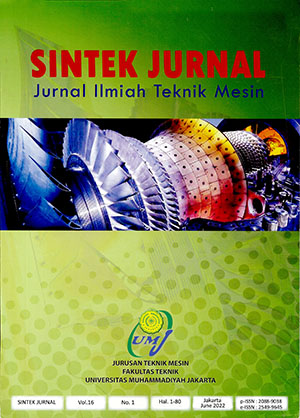Uji performa hybrid turbin angin savonius-darrieus eggbeater
DOI:
https://doi.org/10.24853/sintek.16.1.41-45Keywords:
Vertical Axis Wind Turbine, Hybrid, Savonius, DarrieusAbstract
The development of the Vertical Axis Wind Turbine (VAWT) is still a challenge for several researchers in the world and in Indonesia. Due to the potential of the Indonesian coast generally has an average wind speed of 3-7 m / s which is classified as low wind speed and is very suitable for VAWT which operates at low wind speeds. Combining the 2 existing VAWT types is one of the development efforts on VAWT to improve the performance of these wind turbines. Hybrid VAWT Savonius-Darrieus can increase the coefficient of performance (Cp) where the maximum Cp of savonius is 30% while Darriues is 35%. There have been several researchers making the Savonius-Darrieus Hybrid VAWT prototype producing Cp above 35%, but this is still far from the ideal Cp of wind turbines around 59%. The combination variation of 2 types of VAWT still has the opportunity to be investigated with various variations in construction and variations in additional accessories. The research method that will be carried out is the prototype experimental method, with the design and prototyping stages. The prototype was tested at the Mechanical Engineering Laboratory of the Indramayu State Polytechnic by blowing the wind at a certain speed from the wind tunnel that had been prepared in advance. There were 11 samples prepared, namely 4 samples for 3 levels and 7 samples for 4 levels. There were 5 samples that reached a Cp value of 0.58 which was close to the ideal Cp value, but there was no increase in TSR in all samples.References
D.S.Hasan, R. Hantoro, G. Nugroho, “Studi Eksperimental Vertical Axis Wind Turbine Tipe Savonius dengan Variasi Jumlah Fin pada Sudu,” Jurnal Teknik Pomits, vol. 2 no. 2, pp B-350-B-355, 2013.
Betz’t theory, 1966. Introduction to the theory of flow machines. Oxort: Pergamon Press.
Gupta, R. Das, R. Gautam, S. S. Deka, “CFD Analysis of a Two bucket Savonius Rotor for Various Overlap Conditions”, ISESCO JOURNAL of Science and Technology, vol 8 (13), 2012, 67-74
Kadam, A A. S.S Patil. “A review study on savonius wind rotor for accessing the power performance”. IOSR Jurnal of mechanical and civil engineering. ISSN(e).2278-1684, PP: 18-24.
Mahmoud N.H., A.A. El-Haroun, E. Wahba, M.H. Nasef. “An experimental study on improvement of Savonius rotor performance”, Alexandria Engineering Journal , (51), 2012, 19–25.
R. Sumiati, Hanif, “Rancangan Bangun Rotor Turbin Angin Hybrid Savonius Tipe U Empat Tingkat Dengan H-Darrieus”, Seminar Nasional Energi Telekomunikasi dan Otomasi (SNETO) pp 39-43, 2015.
D. Canra, E. Haris, M. Rahmi. “Analisa Aliran Angin Pada Sudu Turbin Angin Savonius Tipe U Berbasis Software”. Jurnal Teknologi Terapan. Politeknik Negeri Indramayu. Vol. 4 (2).pp 93-101. 2018.
Mohamed Hasan A. M , “Design Optimazation of Savonius and Wells Turbines”, Desertation University of Magdeburg, 2011.
KK. Sharma, A Biswas, R. Gupta. “Performance measurement of a three bladed combined Darrieus - Savonius Rotor”. International Journal Of Renewable Energy Research, Srinagar India, 2013: 885-891.
Effendi, R., Hendra, F., Iyang, R., Pengembangan Desain Prototipe Turbin Angin Sumbu Vertikal Savonius untuk Lampu Penerangan Jalan Umum Berdaya 30 Watt, Prosiding Seminar Nasional Riset dan Teknologi - SEMRISTEK 2018 ISTN Pascasarjana, Jakarta, 2018; 123-134.
S. Mahmud, L. Sampebatu, S.C. Kwang. “Mechanical Power Efficiency of Modified Turbine Blades”. The 6th International Conference on Theoretical and Applied Physics (The 6th ICTAP). pp 040006-1 – 040006-8. 2017.
Downloads
Published
How to Cite
Issue
Section
License
- Articles published in SINTEK JURNAL are licensed under a Creative Commons Attribution-ShareAlike 4.0 International license. You are free to copy, transform, or redistribute articles for any lawful purpose in any medium, provided you give appropriate credit to the original author(s) and SINTEK JURNAL, link to the license, indicate if changes were made, and redistribute any derivative work under the same license.
- Copyright on articles is retained by the respective author(s), without restrictions. A non-exclusive license is granted to SINTEK JURNAL to publish the article and identify itself as its original publisher, along with the commercial right to include the article in a hardcopy issue for sale to libraries and individuals.
- By publishing in SINTEK JURNAL, authors grant any third party the right to use their article to the extent provided by the Creative Commons Attribution-ShareAlike 4.0 International license.















